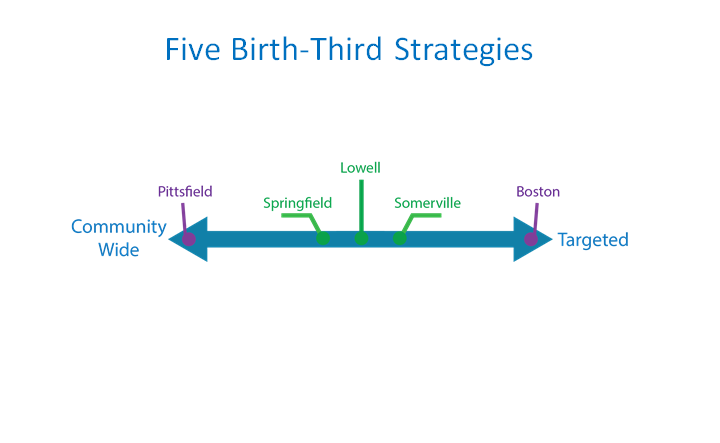This week I’m posting short bulleted summaries of the core strategies of the first five EEC alignment partnerships, an idea prompted by a helpful conversation with Titus DosRemedios of Strategies for Children last week at an ESE Kindergarten Networking Meeting. These updated summaries may be helpful to the seven new communities coming on board in the Round Two grants. You can also find short paragraphs on each community here. Click on the EEC Alignment Partnerships category in the blue panel on the left to see all the posts thus far on these communities.
Pittsfield and Boston represent the ends of the continuum in the graphic above. Springfield, Lowell, and Somerville are all implementing two-pronged strategies that include both community-wide and targeted components.
Pittsfield
- Community Goal: The Pittsfield Promise–90% reading proficiency on the 3rd grade MCAS by 2020
- Berkshire United Way as community backbone organization
- Supported by a strategic plan and six committees
- Focus
- Community-wide family engagement around literacy
- Home-visiting
- Preschool participation, quality and alignment
- Out-of-school time programming
Boston
- Implement BPS K1 (preschool) model in 14 community-based classrooms
- BPS K1 (preschool) model
- Integrated OWL and Building Blocks curriculum
- Making Learning Visible professional development
- Skilled coaching
- NAEYC accreditation
- Demonstrated results; national and international recognition
- Implement model in 14 community-based classrooms (Boston K1DS)
- Teachers with BA degrees
- K1 curriculum
- Professional development
- Compensation
- Potential to expand to additional community-based classrooms contingent on results
- BPS K1 (preschool) model
Springfield
- District and community-based preschool collaboration
- Joint selection of community preschool curriculum
- Joint identification of shared standards
- Priority Teaching Strategies Gold domains
- Social-emotional standards
- Common formative assessments
- Common professional development and outreach
- Public/Private Professional Learning Community Meetings
- Preschool teachers from two elementary schools and several community-based programs
- Cross-site visits
- Define kindergarten readiness
- Expand teacher-to-teacher observations
- Share kindergarten assessment data
Lowell
- Pilot project in two low-income neighborhoods (expanding to three this fall)
- One elementary school, center-based preschools, and family childcare providers in each
- Use of CLASS observations across settings
- Training in Teaching Strategies Gold
- Communities of practice for center-based and family childcare programs
- Professional development workshops
- Use of ECERS-R and FCCERS-R tools
- Addition of coaching beginning this fall
- Family engagement workshops and activities
- Emergent community-wide school readiness agenda
Somerville
- Four strategies focused on early literacy
- Kindergarten Readiness Group
- Public/private preschool and kindergarten teachers
- Half-day workshops over three semesters
- Cross-site visits
- “Using Play to Address Standards” theme
- Literacy coaching
- 8 classrooms (public, private, and Head Start)
- Two observations and debriefs with literacy coach each month all year
- Pre- and post- ELLCO observations
- Teaching Strategies Gold training
- Website for families with young children
- Outreach to parents on use of site through agencies
- Kindergarten Readiness Group
- Universal Kindergarten Readiness Plan
This post was completed as part of a contract between the MA Department of Early Education and Care and Cambridge Education (where David Jacobson worked at the time). Contract # CT EEC 0900 FY13SRF130109CAMBRID.
